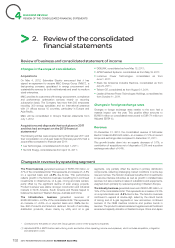APC 2012 Annual Report Download - page 152
Download and view the complete annual report
Please find page 152 of the 2012 APC annual report below. You can navigate through the pages in the report by either clicking on the pages listed below, or by using the keyword search tool below to find specific information within the annual report.
2012 REGISTRATION DOCUMENT SCHNEIDER ELECTRIC150
BUSINESS REVIEW
4TRENDS IN SCHNEIDER ELECTRIC’S CORE MARKETS
>
1. Trends in Schneider Electric’s core
markets
Industries and machine manufacturers
Our industry market experienced a contraction in 2012 after
enjoying a sharp rebound since the trough of the previous
recession mid 2009. Continuing debt crisis in the Euro zone along
with political uncertainty in China and the US have depressed
business and consumer confi dence, leading companies to focus
on cost cutting and investment downscales. Trend stabilized
over the second semester.
In Western Europe, sovereign debt crisis and uncertainties over the
future of the zone led to plunging business confi dence and lower
fi nal demand. Furthermore, production capacity utilization declined,
reducing the need for equipment spending and maintenance. Some
improvements have been noticed at the end of the year.
In the US, trend slowed down in the second half after a strong
fi rst semester, with manufacturing seeing slow growth abroad and
stalled business investments at home.
China, where the OEM market has by now become the largest
worldwide, slowed down after several years of double digit growth,
impacted by deterioration in both inland manufacturing investments
and export. In addition, decreasing importation of machines in
China hit the OEM production of other regions abroad. In new
economies excluding China, market growth remained positive as a
whole, although penalized by a lower foreign demand.
On the end user side, investment cautiousness was felt in the
project business in the second half of the year. Cash constraints and
overall economic uncertainty reduced demand for new projects and
subsequent investments. This was particularly true for investments
in Mining-Mineral-Metals segment in the second half of the year. Yet
some investment areas remained very active in2012 such as gas.
This reduction in capex came along with an increased focus on
production, with end users looking more into optimizing existing
assets through smaller opex projects and services. Success
of important water services contract in Sydney illustrates this
shift. Similarly, we benefi ted from the end user focus on energy
management, in particular in the Food&Beverage industry.
Non residential buildings
In the US, non-residential construction experienced a recovery
in 2012 as a whole, driven by industrial buildings, offi ce and
retail, whereas government buildings, public education and
public healthcare segments decreased. However, trend slowed
down during the second semester, impacted by weaker foreign
environment and uncertainty regarding the fi scal cliff. Beyond
this short term volatility, the recovery was constrained by excess
capacity that still needed to be absorbed and continued tightness
in lending conditions.
In Western Europe, non-residential construction declined further
in2012 with the intensifi cation of the implementation of austerity
policies and harsh lending conditions. The usual disparities between
countries should be highlighted: Iberian countries continued to
plunge while Nordic countries showed resilience in the face of the
European crisis.
Non residential construction slowed down in Australia and China,
dragged by past tight credit conditions over past quarters and less
favorable inland and foreign environment.
Residential
In Western Europe, 2011 trend showing improvement in housing
construction was not confi rmed in 2012. Recovery was delayed
because of ongoing economicand sovereign debt crisis, bringing
austerity measures along with lack of confi dence and rising
unemployment. Housing construction decreased in 2012 in
Europe, but a noticeable heterogeneity between countries has
to be underlined. Indeed, losses in South of Europe dampened
global European fi gures, while Germany, Norway, Switzerland,
outperformed other European countries.
In the US however, housing improved due to growing consumer
confi dence and declining vacancy rates. An increase of 20% in
housing starts in2012 supports evidence of this recovery, despite
a very low base. However, economic uncertainty and harsh lending
conditions continued to weigh down on residential construction.
In Asia Pacifi c, residential construction deteriorated in our main
markets. In Australia, residential construction declined sharply
in2012, but housing starts showed fi rst signs of recovery at year-
end. In China, housing starts decreased in2012 after several year
of tremendous growth. This can be explained by the Chinese
government’s policy, which aims to restrain developers’ activities
and to limit housing purchase.
























